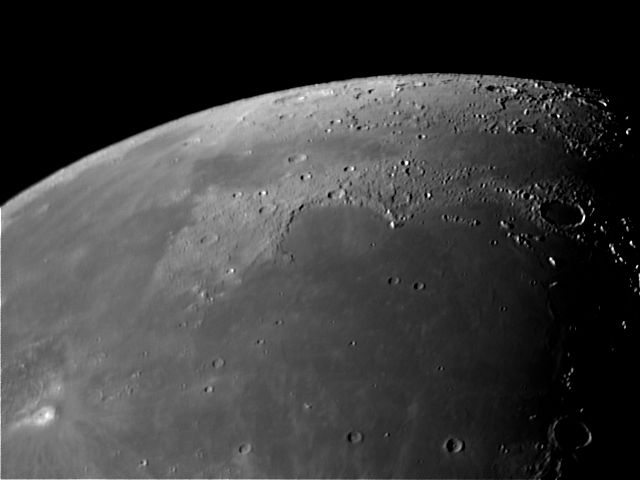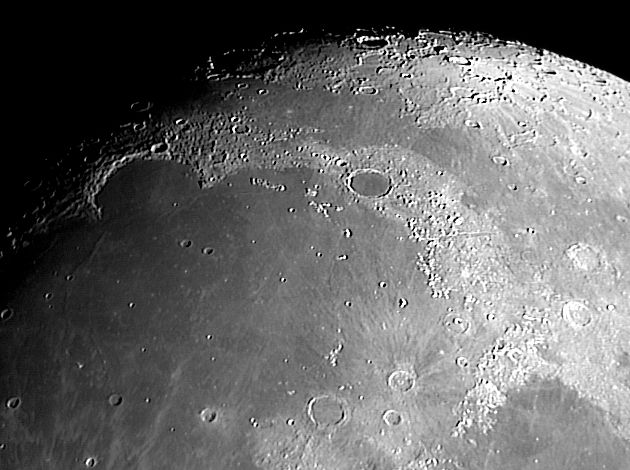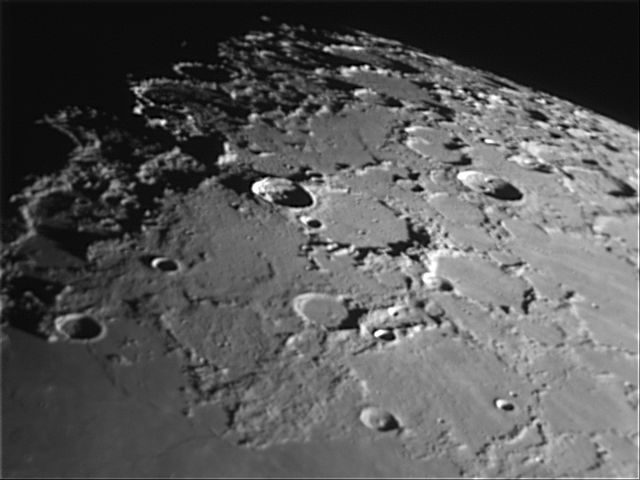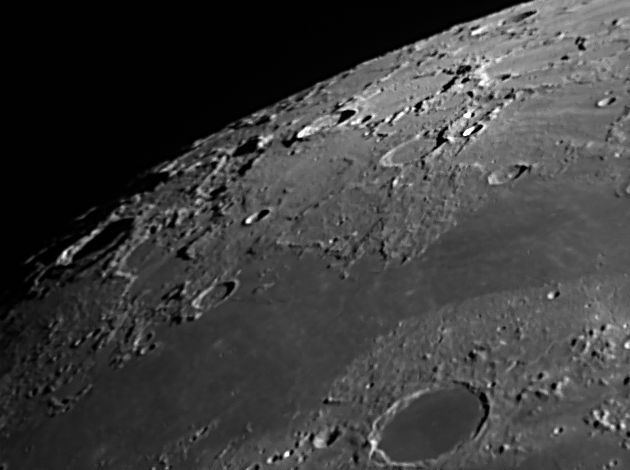The North 
Move your mouse over the picture to see the names of the various features. Scale markers in an area so near the limb are not really useful, so I have not attempted to supply them here. To be helpful, below are the diameters, in kilometres, of some of the craters in these pictures.
| Anaxogoras | 53 | |
Goldschmidt | 124 | |
Scoresby | 58 |
| Pythagoras | 133 | |
Philolaus | 73 | |
Peary | 77 |
| J. Herschel | 160 | |
Plato | 104 | |
Fontenelle | 39 |
| Byrd | 97 | |
Epigenes | 56 | |
Timocharis | 36 |

|
This picture shows much of the north-west quadrant of the Moon, the Mare Imbrium and various features to the north.
It was taken with a ToUcam attached to my LX200 with a 0.33 focal reducer on 16th December 2003 at 04:47 UT, when the Moon was 21.6 days old.
Date and Time: 16th December 2003 04:47 UT
Camera: ToUcam 740K
Telescope: LX200 with Meade 0.33 focal reducer
Capture: K3CCDTools. 50% gamma, 1/500", 10% gain, 303 frames
Processing: Registax. 116 frames stacked. Wavelet 1 = 5 |
|

|
This picture, at the same scale as the one above, was taken when the Moon was 11.5 days old and shows the northern area east of Sinus Iridum. There are plenty of named features in this area. A slight difference in albedo (brightness) can be seen in the surface of Mare Imbrium which is more clearly seen in a exaggerated-colour version and implies that the eastern part of Mare Imbrium is covered in something different from the western side. The same difference can be seen in a closer version imaged in infra-red light.
It was taken with a ToUcam attached to my LX200 with a 0.33 focal reducer on 12th November 2005 at 20:38 UT, when the Moon was 11.5 days old.
Date and Time: 12th November 2005 20:38 UT
Camera: ToUcam 740K
Telescope: LX200 with Meade 0.33 focal reducer, IR-block and Neodymium filters
Capture: K3CCDTools. 0% gamma, 1/100", 25% gain, 617 frames
Processing: Registax. 174 frames stacked. Wavelet 1 = 10, gamma 1.5, histogram 22-200 |
|

|
This is a picture of the far north taken a day after first quarter. The libration in latitude is such that the north pole is tipped towards us, and the Sun was one degree north of the lunar equator, so the North Pole is displayed and in sunlight. It is difficult to see exactly where the pole is in any picture taken from Earth, but it resides in a small crater on the rim of Peary. In the mouseover I have indicated where I think it is with an arrow that points down the prime meridian, which passes through Epigenes A.
Because the libration (6°56') exceeds the solar angle (1°) the edge at the very top is the terminator not the limb. This can be seen from the isolated mountain that is just catching the Sun on the top-left of the image. I cannot identify this mountain (remarkably few mountains on the near side of the Moon have names let alone on the far side), but there is a massif between Peary and two large craters on the far side called Hermite and Rozhdestvenskiy. I assume it is a high point in that mountain range.
The picture was taken with a DMK camera attached to my LX200 on 27th December 2017 at 19:14 UT, when the Moon was 8.8 days old.
Lunar Phase: 72.3°
Colongitude: 24.7°
Libration: +6° 56' in latitude, -7° 49' in longitude
Date and Time: 27th November 2017 19:14 UT
Camera: DMK 21AF04
Telescope: LX200-10 with Atmospheric Dispersion Corrector
Capture: ICCapture. 1/618", gain 727, 1800 frames
Processing: Registax6. 14 alignment points, 100 frames stacked per point. Wavelets 1,2 = 10, gamma 1.5 |
|

|
This picture of the North was taken on lunar day 10 and so the western edge is the terminator, not the limb. The libration is also very unfavorable for this area so some craters are not well displayed. Almost all the craters here are ancient and date to before the Imbrium impact. Consequently they are battered and filled with Imbrium ejecta. The major exception is Anaxagoras, in the middle of the picture, which is Copernican age and has littered the area with bright rays and secondary craters. Although somewhat smaller, Anaxagoras is very similar to Tycho in the south and would rival that crater if only it was not quite so far north and so better displayed.
I have not attempted to put scale markers in the mouseover and, as the north pole is not visible, I have not indicated the prime meridian either. Suffice it to say that Anaxagoras is only 2° west of due north of Plato.
The picture was taken with a DMK camera attached to my LX200 on 11th May 2022 at 21:23 UT, when the Moon was 10.1 days old.
Date and Time: 11th May 2022 21:23 UT
Lunar Phase: 56.4°
Colongitude: 40.9°
Libration: -5° 5' in latitude, -7° 6' in longitude
Camera: DMK 21AF04
Telescope: LX200-10
Capture: ICCapture. 1/500", gain 962, 3416 frames
Processing: Registax5. 1253 frames stacked. Wavelets 1,2 = 10
Focus Magic 2 |
Home Lunar Index





